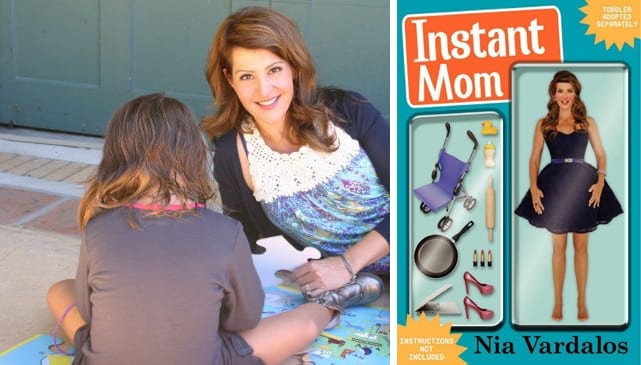When I found out I’d get to interview Academy Award nominated screenwriter and (fabulous) actress Nia Vardalos, I actually let out a girlie squee.
This wasn’t just because she’d written and starred in two of my favorite movies – My Big Fat Greek Wedding and My Life in Ruins. Mainly, I knew we’d get along because of three things:
1. We are both Libras
2. We both love Imagination Movers (and think they’re hot)
3. Both of us have daughters who have said unexpected things like, “My daddy has a big, big penis” to whomever happened to be standing there at the time.
But after reading her book, Instant Mom, I knew we’d get along for a fourth reason: We’d both gone down the road to adopt from the foster care system.
In her book, Nia candidly chronicles the events that lead her and her husband, actor Ian Gomez (Cougartown, Drew Carey Show) towards adoption. After the old standard wasn’t working for them, they went through thirteen rounds of IVF and used a surrogate.
In Chapter 5, Nia endures a difficult round of fertility treatment only to be told an accident had occurred in the lab and the proposed in vitro round could not continue.
Even after she came to the decision that they would not have a bio child, she never gave up the idea of being a mother. “After I made peace with it (not conceiving), motherhood became my focus.”

They put themselves on every list in US, Canada, and even Greece. They considered every possibility for adoption, but one. After talking to numerous agencies and attorneys, at the recommendation of a friend, she and Ian sat down with an adoption counselor: facilitator who asked them point blank if they’d ever considered adopting out of the American Foster Care System.
What she discovered was there were “over 129,000 children in the US that were legally free to be adopted from the foster care system and over 500,000 living in foster homes.” [1] (Legally free means parental rights have been terminated and family routes for placement have been exhausted due to financial ability, criminal history, or family has turned down the child for any reason.)
Nia said considering fost-adopt made sense. “I could see myself very clearly as a mother, I didn’t necessarily see myself with an infant”, but she needed time to recover from trying to conceive for so long. The treatments had been brutal to her body and mind. She “checked out” of acting for a bit, focused on regaining her health and wellness and continued writing.
Then in 2007, she wrote “the grieving period was over” and she felt strong and ready to learn about the fost-adopt process.
After seemingly endless paperwork, Nia and Ian also connected with Foster Family Agency (FFA), a free state service “to help them navigate the state system.” Many states require potential adoptive parents to have an agency to serve as a go between them and the state. (These people can be your biggest advocates and saviors when asking questions and deciphering the legalese.) During this period, they took parenting classes, CPR certification, and completed a home study.
Within a year, they’d been matched with a three-year old girl who didn’t speak very much and who’d been in the foster system since birth, but after their first meeting, Nia and Ian knew they’d be a family.
They met their future daughter the next afternoon. The little girl had golden highlights in her hair, just like Nia pictured in a dream three years before.
After a great initial meeting with the child, social workers, and attorneys, Nia and Ian said good-bye and placed her in her car seat. “Bye, Mommy,” the little treasure said and they all looked at each other with wide-eyed amazement because this child hadn’t spoken all day.
Within a week, they had her at their home and she turned it upside down in both good and very trying-ways.
 Because of her previous happily ever after stories (My Big Fat Greek Wedding and My Life in Ruins), some could accuse her of sugarcoating the adoption of a foster child.
Because of her previous happily ever after stories (My Big Fat Greek Wedding and My Life in Ruins), some could accuse her of sugarcoating the adoption of a foster child.
She sighs and says, “They need to read the book.”
Agreed. She’s very honest about how their daughter only slept for an hour at a time at night, how she physically fought Nia and Ian, even kicking Nia in the neck at one point, but she and Ian remained united and determined to nurture their daughter. To make it work, because their daughter was simply “protecting herself” and they had to earn her trust.
Within a month, things began to settle. In a very sweet moment, Nia writes about the day they tried a new name for their daughter. They would say names to her and see her reaction. They went through their list…Evelyn, Bella, Clio and numerous others. The little girl didn’t seem to like any of them, but Nia came across a name in a book– Ilaria. In Greek it means “something that is joyous and funny.” (Give me a word, any word, and I show you how the root of that word is Greek…. sorry, I had to do it.)
“My daughter looks up and her expression says, ‘Yeah.’ She is smiling. Just like how she chooses us, she chooses her name.” [2]
?Nia writes about how, over the next few months, they help Ilaria heal and how they earn her trust and grow as a family. She includes the slow progression of her daughter’s sleep habits, her accomplishments in speech therapy, and the emotional help they received from friends, family, and the social workers. “I don’t leave anything out.” Vardalos adds.
Mentioning these difficulties could discourage potential parents to investigate adopting a child from foster care, but honestly, what child is problem-free?
No child is without problems, no matter if they are genetically yours or adopted from across the ocean.
To be fair and honest, children from the foster care system do start from a different center and can have more hurdles to cross, but they aren’t all broken or hopeless cases. “The biggest misconception about kids in foster care is they are damaged,” Vardalos says. “There is no child that can’t be helped through love, understanding, patience, and therapy.”
Patience. That word comes up a lot for any parent, but she said ironically, her training through the foster care workers and counselors made her very patient not only when her daughter first arrived, but since. Even to the point of surprising herself.
“A friend of mine watched me deal with a situation with my daughter and she looked at me and said ‘you handled that really well. You were so patient. I think I might try that’ and she did!”
.jpg)
(Vardalos and her daughter)
Ilaria is now eight and thriving. Nia and Ian have found a good groove with their daughter, teaching her Greek and Spanish (Ian’s part Puerto Rican) and Nia says, “If we find she’s got a specific ethnicity in her genes, we’ll help her learn that language as well.”
One of the main concerns people ask about fost-adopt is “how much information do you get about the child’s family history?” When adopting from the foster care system, it’s required you get a copy of the child’s file, everything known about the family history is included. Most, if not all, states require you read the file before finalizing adoption.
Nia said they had their long-time friend and family attorney read it and asked, “Is there something important we should know?” She focused more on family medical history as opposed to the circumstances of Ilaria’s birth and journey into the state system. “He said, no. So we sealed the file and we’ll all look at it together when she’s ready. That way when she asks me specifics of it, I don’t want to lie to her. I truly don’t know.”
Nia applauds her husband, her family and her tight group of friends whom she calls “The Core” for helping her through this entire process. With such a tight group of support around, it’s a far nicer journey through adoption and parenting.
Like so many of us, we all get advice from well meaning friends and strangers and Nia and Ian are no exception.
Best parental advice she’s ever gotten? “I had a friend who said ‘don’t make everything a lesson.’ And she was right.”
And the worst? Nia laughs, “My daughter has a natural turn off valve. She’ll take two bites of something and say she’s done. A woman I know said, ‘Oh that’s good. You keep that up and tell her you don’t want her to eat too much or she’ll look bad in her bikini when you go to Bali for holiday.’ Who says that to an eight year old?”
For now, Nia continues her work as an advocate for adoption and of course, like every other parent on the planet, when you have one, people ask, are you going to have more? “We’re on a list, but you know, I’m okay right now.”
For those wanting information about adoption in general, the Appendix of Nia’s book has twenty-five of the most asked questions about adoption, including how to adopt from other countries, what their requirement and restrictions are, and the general costs.
Want more information about fost-adoption? Contact your state’s Department of Child and Family services or an agency in our community that specializes in fost-adoption. You can also go to www.childwelfare.gov/nfcad to locate a Foster Family Agency in your state.
[1] Instant Mom – Chapter 6 Road to Adoption
[2] Instant Mom – Chapter 11 What’s in a Name Anyway?





